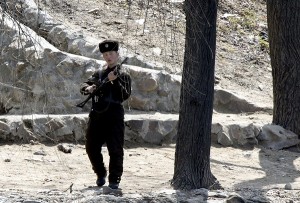
In this Wednesday, April 10, 2013 photo, a North Korean soldier holds his rifle patroling on the river bank of the North Korean town of Sinuiju, opposite to the Chinese border city of Dandong. North Korea has been repeatedly moving multiple missiles around in an apparent bid to confuse outside intelligence gatherers ahead of an expected launch or to create an impression that it is planning multiple launches. (AP Photo) CHINA OUT
SEOUL, South Korea—North Korea has been repeatedly moving multiple missiles around in an apparent bid to confuse outside intelligence gatherers ahead of an expected launch or to create an impression that it is planning multiple launches.
According to intelligence analysis cited by the South Korean news agency Yonhap, two midrange Musudan missiles have been repeatedly moved in and out of a warehouse on the North Korean east coast.
At the same time, at least five mobile launch vehicles have also been spotted swapping places and positions.
“There are signs the North could fire off Musudan missiles any time soon,” an intelligence source told Yonhap.
“But the North has been repeatedly moving its missiles in and out of a shed, which needs close monitoring.”
Another source suggested Pyongyang was hoping to “fatigue” South Korean and US intelligence gatherers who have been on a heightened state of surveillance alert since Wednesday.
Untested missiles
The midrange missiles mobilized by the North are reported to be untested Musudan models with an estimated range of anywhere up to 4,000 kilometers.
That would cover any target in South Korea and Japan, and possibly even US military bases on the Pacific island of Guam.
North Korea has proved quite adept at confounding intelligence monitoring in the past.
Its long-range rocket launch in December was widely flagged in advance and was subjected to intense satellite scrutiny.
In the end, the rocket blasted off hours after a succession of South Korean media outlets, citing satellite imagery analysis by government, diplomatic and military sources, suggested the launch was facing a lengthy delay.
Yonhap had quoted military officials as saying the entire three-stage Unha-3 carrier had been removed from the launch pad and returned to a nearby assembly facility for repair.
Various Japanese media on Thursday reported defense officials confirming that at least one of the North Korean mobile launchers had placed its pad in a launch-ready position.
The reports also said that such moves could be deliberate attempts by North Korea to sow confusion and did not necessarily indicate a launch was imminent.
A defense ministry spokesperson contacted by AFP declined to comment, citing a desire not to compromise secrecy surrounding intelligence-gathering capabilities.
Japan’s Chief Cabinet Secretary Yoshihide Suga, asked about the reports, said the government was doing everything it can “to protect the lives and the safety of our people.”
“We are aware of all sorts of information. We are sharing information with South Korea and the United States,” Suga said.
Guam raised its official threat level on Thursday after warnings from North Korea identifying the island as a potential missile target.
With a missile test expected at any time, authorities said the US territory in the western Pacific was on yellow alert, the middle phase of a three-step “traffic light” system composing of green, yellow and red levels.
“This means we should continue with our daily lives while preparing ourselves for any potential of an emergency,” the Guam government said in a statement, describing the risk to the island as “medium.”
“It also means the government pulls its resources together through the emergency operations center to ensure we are prepared to respond to emergencies,” the government said.
Guam’s emergency alert system, which sets off sirens across the island and interrupts regular television and radio broadcasts to deliver information, was tested at 10 a.m. Thursday.
Gov. Eddie Calvo said the test had been successful and the Guam Department of Homeland Security’s joint information center was now operating 24 hours a day to provide advice to the island’s population of 180,000.
Homeland Security has described the chances of a North Korean attack as remote, noting that Guam “is protected by the greatest nation and military in the world, the United States of America.”
Precaution
But as a precaution, it launched a campaign this week urging residents to prepare emergency kits and family disaster plans.
Fact sheets have been distributed around the island advising residents on how to protect their families, stay informed and perform tasks such as blast-proofing doors and windows with plastic and tape.
Calvo said he had received assurances from US military commanders on the island, which bristles with American military facilities and bases, that defenses were “strong and adequate.”
Guam, which came under US control in 1898 after the Spanish-American War, lies about 3,380 km southeast of North Korea, meaning it is theoretically in range of Pyongyang’s missiles.
Washington has scrambled to deploy its Thaad (Terminal High Altitude Area Defense) missile shield to Guam, a truck-mounted system capable of tracking and shooting down an enemy projectile.